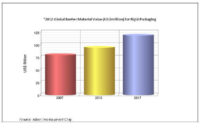Since the development of BOPA film in the 1970s, 2-stage sequential stretching has become the favored technology for the production of bi-oriented polyamide (BOPA) films. However, in recent years end uses have emerged that have required more balanced film properties and simultaneous stretching technology is the only one able to meet these needs.
This is one of the main conclusions from PCI’s (pcifilms.com) latest report on the US$1.1 billion global BOPA film market. Report author Simon King, notes, “In today’s BOPA film market users are telling us that a balanced film with better dimensional stability and less shrinkage is particularly important for some applications. It is not surprising then that over the next five years most of the new BOPA film lines to be installed are based on simultaneous stretching technology to meet the technical demands of these high-end applications”.
In the early days BOPA film production technology was developed and licensed by a small number of Japanese companies using either bubble or simultaneous film extrusion and stretching techniques. It wasn't until the development of the off-the-shelf, 2-stage sequential stretching lines, with higher outputs and lower costs of production, that the global BOPA film industry began its rapid expansion into flexible packaging. More recently the emergence of high growth sectors, such as the packaging of retort processed foods and pharmaceuticals has put different technical demands on films which are only really being matched by the products extruded on simultaneous orientation lines.
According to PCI, the global market consumed 230,000 tonnes of BOPA film in 2013 and over the next five years demand is expected to grow by a further 60,000 tonnes. A significant proportion of this growth is expected to come from emerging end uses requiring more balanced film properties. In response to the growing demand from customers film producers are investing in new simultaneous biaxial orientation lines at such a rate that PCI estimates that 25% of the installed global BOPA film capacity will using this type of technology by 2018, compared to only 16% in 2013.
PCI Films Consulting’s “World BOPA Film Market Trends to 2018” will be an invaluable tool to guide business planning, investment and future product developments. Based on original field research, it is the most recent and comprehensive report available on this niche market, providing historical data and highly detailed market analysis and statistics for 2013 and forecasts through to 2018.



